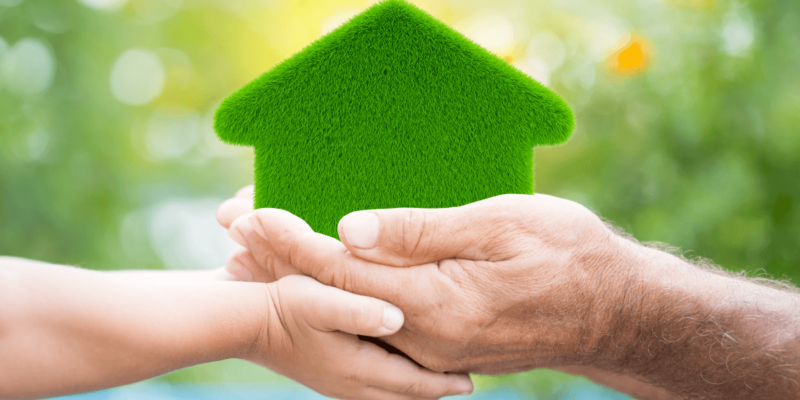
The importance of sustainable living and reducing our environmental footprint cannot be overstated. From simple lifestyle adjustments to more significant renovations, each of these 40 suggestions promotes sustainability and reduces your carbon footprint while making your home more eco-friendly.
With mounting environmental challenges, adopting eco-conscious habits is crucial, starting within our living spaces. We can inspire others to be responsible stewards of the Earth’s resources if we prioritise sustainability and reduce our ecological footprint. This fosters a collective commitment towards the environment and encourages others to follow suit.
Embracing eco-friendly practices in the home has many benefits – ranging from reduced carbon emissions to enhanced indoor air quality. Residents and families can make their living environments healthier and more comfortable – for themselves and future generations – by choosing eco-friendly products, implementing water-saving measures, and investing in energy-efficient appliances.
Table of Contents
Energy Efficiency at Home
Several actionable steps can significantly reduce your environmental impact and utility bills. These measures benefit the environment, offer long-term savings, and contribute to a more resilient and sustainable future for individuals and communities.
- Installing Energy-efficient Appliances: Replace old, inefficient appliances with Energy Star-rated models to reduce electricity consumption significantly.
- Upgrading to LED lighting: Switching to LED bulbs lowers energy usage and ensures your lighting fixtures last longer than traditional incandescent bulbs.
- Sealing Drafts and Improving Insulation: You can maintain consistent indoor temperatures and reduce the need for heating and cooling, by sealing gaps around doors & windows and improving insulation.
- Using Programmable Thermostats: These allow precise control over heating and cooling, optimising energy usage based on your schedule.
- Harnessing Solar Power with Panels or Solar-Powered Gadgets: These panels or devices tap into a vast renewable energy source – reducing reliance on fossil fuels and lowering carbon emissions.
Water Conservation at Home
Conserving water at your residence is crucial for sustainability and reduction in costs. By implementing simple yet effective measures, households can significantly decrease water consumption and contribute to environmental preservation.
- Fix leaks and drips: Prompt repairs can prevent water wastage and enhance water conservation efforts.
- Install low-flow faucets and showerheads: Low-flow fixtures reduce water flow without compromising water pressure, leading to substantial water savings over time.
- Collect Rainwater for Outdoor Use: Harvesting rainwater with barrels or tanks provides a sustainable source for watering plants and landscaping, reducing reliance on treated water.
- Opt for Water-Saving Appliances: Water-efficient appliances such as dishwashers and washing machines minimise water usage during daily tasks.
- Water Outdoor Plants Efficiently with Drip Irrigation or Rain Barrels: These deliver water directly to the roots of plants, maximising efficiency and reducing water runoff and evaporation.
Sustainable Materials in Home Construction
Incorporating these materials is essential for minimising environmental impact and promoting eco-conscious living.
- Choose Eco-friendly Flooring Options: Bamboo and cork are renewable materials that offer durability and sustainability, making them ideal solutions for flooring.
- Non-toxic Paints and Finishes: These can decrease indoor air pollution and promote better indoor air quality, which can contribute to creating a healthier living environment.
- Use Reclaimed or Recycled Materials in Renovation Projects: Incorporating materials such as reclaimed wood or recycled glass countertops reduces waste and gives new life to old materials, adding character and sustainability to home renovations.
- Furniture Made from Sustainable Materials: Reduce environmental impact and add unique, stylish elements to your home decor by investing in sustainably sourced wood, recycled materials, or reclaimed wood.
- Incorporate Natural and Organic Textiles in Home Decor: Choosing organic cotton, hemp, or linen for upholstery and bedding promotes sustainability and reduces exposure to harmful chemicals in conventional textiles.
Waste Reduction
Waste reduction at home is vital for conserving resources and mitigating your environmental impact.
- Practise proper recycling and composting: Sorting recyclables and organic waste for composting diverts materials from landfills, reducing environmental pollution and promoting resource conservation.
- Minimise single-use plastics: Avoid bags, bottles, and packaging to reduce plastic pollution and conserve natural resources.
- Buy Products with Minimal Packaging: Minimal or recyclable packaging reduces waste and encourages producers to adopt more sustainable packaging practices.
- Repair and Repurpose Items Instead of Throwing them Away: Extend the lifespan of items through repair and repurposing; this also minimises waste generation and reduces the need for new purchases.
- Donate or Sell Unwanted Items: Extend the usefulness of items you no longer need, by giving them a second life. Someone else may need them more strongly than you can imagine.
Indoor Air Quality
The quality of indoor air plays a crucial role in ensuring a healthy and comfortable living environment. To promote respiratory health and overall wellness, people can implement certain strategies that can reduce indoor pollutants and improve ventilation.
- Use Air-purifying Plants: Incorporating spider plants and peace lilies can remove airborne toxins and improve indoor air quality.
- Improve Ventilation with Natural Airflow and Air Filters: Enhancing ventilation through open windows and using air filters helps circulate fresh air and remove pollutants, reducing indoor air contaminants.
- Choose Non-toxic Cleaning Products: These minimise exposure to harmful chemicals and improve indoor air quality, creating a safer environment for occupants.
- Avoid Synthetic Fragrances and Opt for Natural Alternatives: Air fresheners and cleaning products containing synthetic fragrances could emit volatile organic compounds (VOCs) that can be harmful. Essential oils, a natural alternative, offer a safer and more environment-friendly aroma.
- Keep Indoor Humidity Levels in Check: Mould and mildew growth can contribute to respiratory issues; maintaining indoor humidity levels between 30% and 50% can prevent this.
Sustainable Gardening
Embarking on sustainable gardening cultivates a mindful relationship with nature.
- Start a Home Garden for Fresh Produce: Grow fruits and vegetables on your own, reducing reliance on store-bought produce and minimising carbon footprint.
- Use organic Gardening Practices: Avoid synthetic fertilisers and pesticides and opt for natural alternatives to promote soil health and biodiversity.
- Create a Wildlife-friendly Garden with Native Plants: This can attract birds, butterflies, and bees, fostering a balanced ecosystem.
- Compost Kitchen Scraps and Yard Waste: Turn organic waste into nutrient-rich compost to enrich soil and reduce landfill contributions.
- Install a Rain Garden or Permeable Paving to Manage Stormwater Runoff: These features can capture and filter rainwater, preventing erosion and reducing water pollution.
Energy Monitoring and Management
For a greener future and a more cost-effective household in terms of energy, you can leverage smart home technology, adopt energy-efficient HVAC systems, employ home automation for optimised energy usage, conduct regular energy audits, and educate your family on energy-saving practices.
- Use Smart Home Technology for Energy Monitoring: Employ smart devices and apps to track energy usage in real time, allowing for informed decisions on consumption habits.
- Implement Energy-efficient HVAC Systems: Install high-efficiency heating, ventilation, and air conditioning systems to reduce energy consumption and lower utility bills.
- Consider Home Automation for Optimal Energy Usage: Utilise automated systems to control lighting, heating, and cooling – thus optimising energy usage based on occupancy and preferences.
- Conduct Regular Energy Audits to Identify Areas for Improvement: Assess energy usage patterns and identify opportunities for efficiency improvements, such as sealing drafts or upgrading insulation.
- Educate the Family on Energy-saving Practices: Promote awareness and encourage behaviour changes, such as turning off lights and appliances when not in use, to reduce energy waste and promote sustainability together.
Eco-friendly Methods of Transportation
You can significantly promote environmental stewardship by opting for eco-friendly modes like biking or public transit, carpooling, and investing in electric or hybrid vehicles.
- Opt for eco-friendly transportation options: Choose biking or public transport whenever possible, to reduce emissions and promote healthier, greener commuting.
- Carpool or use ridesharing services: Share rides with others to reduce the number of vehicles on the road and decrease overall emissions.
- Invest in Electric or Hybrid Vehicles: Transitioning to electric or hybrid cars reduces reliance on fossil fuels and decreases air pollution.
- Plan Tasks Efficiently to Minimise Driving: Consolidate and plan routes to minimise driving distances – thus saving time and reducing fuel consumption.
- Support Local Businesses in Reducing their Carbon Footprint from Transportation: By patronising local businesses, you can reduce the need for long-distance transportation of goods.
Conclusion
We explored 40 actionable ways to transform your home into an eco-friendly haven, ranging from energy efficiency and waste reduction to sustainable gardening and transportation choices. With a multitude of opportunities, you can positively impact the environment right from your doorstep.
Recognising the collective impact of individual actions on environmental conservation is essential. Whether using energy-efficient appliances, composting organic waste, or supporting local businesses, every choice makes a significant difference in reducing our carbon footprint and preserving natural resources.
We can strive towards a sustainable future where both people and the planet flourish by adopting eco-friendly practices, promoting sustainability, and encouraging others to join the movement.
FAQs
1. How can I make my home more eco-friendly?
You can make your home more eco-friendly by installing energy-efficient appliances, reducing water consumption, using sustainable materials for construction and furnishings, implementing proper waste management practices, and incorporating renewable energy sources like solar panels.
2. What are 5 things you do at home to be eco-friendly?
5 things you do at home to be eco-friendly are: 1. Turn off lights and appliances when they are not being used 2. Reduce plastic waste by using reusable bags, bottles, and containers 3. Recycle paper, glass, plastic, and other recyclable materials 4. Create nutrient-rich soil for gardening by composting organic waste 5. Choose eco-friendly cleaning products and reduce overall chemical usage
3. How can I be 100% eco-friendly?
You can be nearly 100% eco-friendly by minimising your carbon footprint, using renewable energy sources, reducing waste generation, supporting sustainable practices, and being mindful of your environmental impact in all aspects of life.
4. How can I live greener at home?
You can live greener at home by reducing energy consumption, conserving water, minimising waste, opting for eco-friendly products and materials, supporting local and sustainable businesses, and practising eco-conscious habits in your daily routines.
5. What is eco-friendly in a house?
Eco-friendly features in a house are energy-efficient appliances, LED lighting, low-flow fixtures, eco-friendly building materials (such as bamboo flooring or recycled glass countertops), proper insulation, passive solar design, and renewable energy systems like solar panels or wind turbines.
6. What are eco-friendly ways?
Eco-friendly ways are practices and actions that minimise environmental harm, conserve natural resources, and reduce pollution. These include opting for renewable energy sources, recycling and reusing materials, reducing energy and water consumption, supporting sustainable agriculture, and minimising carbon emissions.
7. What is an eco-friendly lifestyle?
An eco-friendly lifestyle includes making conscious choices and adopting behaviours that prioritise environmental sustainability – such as reducing waste, conserving resources, minimising carbon footprint, supporting eco-conscious products & practices, and promoting biodiversity and ecological balance.
8. What is the most eco-friendly house?
The most eco-friendly houses are those designed and built with sustainable materials, energy-efficient features, and minimal environmental impact.
9. How can we go green?
You can go green by adopting environment-friendly practices such as reducing energy consumption, conserving water, recycling and composting, using eco-friendly products, supporting sustainable initiatives, and advocating for environmental protection and conservation policies.
10. Why should we be eco-friendly?
We should be eco-friendly to protect the environment, preserve natural resources, address climate change, reduce pollution, and create a sustainable future for generations to come. Being eco-friendly also helps improve public health, promote biodiversity, and foster a more equitable and resilient society.









